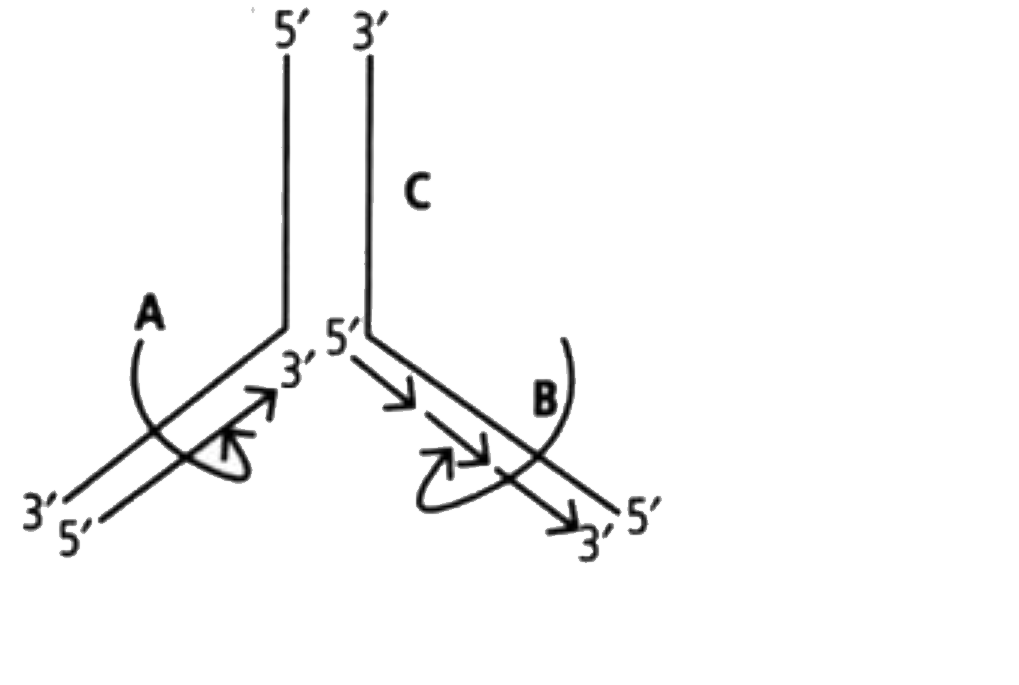Study the given portion of double stranded polynucleotide chain carefully. Identify a,b , c , and the 3' and 5' end of the chain
To solve the question regarding the identification of components in a double-stranded polynucleotide chain, we will follow these steps:
1. Identify Component A:
- In the double-stranded polynucleotide chain, component A represents the hydrogen bonds that hold the two strands together. These bonds can be either double bonds (between adenine and thymine) or triple bonds (between cytosine and guanine).
2. Identify Component B:
- Component B is identified as a purine. In this context, it specifically refers to adenine (A), which is a purine base. Purines are characterized by their double-ring structure.
3. Identify Component C:
- Component C is identified as pentose sugar. In DNA, this sugar is deoxyribose, which consists of five carbon atoms (hence the name pentose).
4. Identify the 3' End:
- The 3' end of the polynucleotide chain is characterized by the presence of a hydroxyl group (OH) attached to the third carbon of the sugar molecule. This end is crucial for the addition of new nucleotides during DNA replication.
5. Identify the 5' End:
- The 5' end of the polynucleotide chain is characterized by the presence of a phosphate group (P) attached to the fifth carbon of the sugar molecule. This end is important for the formation of the backbone of the DNA strand.
Summary of Identifications:
- A: Hydrogen bond
- B: Purine (Adenine)
- C: Pentose sugar (Deoxyribose)
- 3' End: Hydroxyl group (OH)
- 5' End: Phosphate group (P)
- In the double-stranded polynucleotide chain, component A represents the hydrogen bonds that hold the two strands together. These bonds can be either double bonds (between adenine and thymine) or triple bonds (between cytosine and guanine).
- Component B is identified as a purine. In this context, it specifically refers to adenine (A), which is a purine base. Purines are characterized by their double-ring structure.
- Component C is identified as pentose sugar. In DNA, this sugar is deoxyribose, which consists of five carbon atoms (hence the name pentose).
- The 3' end of the polynucleotide chain is characterized by the presence of a hydroxyl group (OH) attached to the third carbon of the sugar molecule. This end is crucial for the addition of new nucleotides during DNA replication.
- The 5' end of the polynucleotide chain is characterized by the presence of a phosphate group (P) attached to the fifth carbon of the sugar molecule. This end is important for the formation of the backbone of the DNA strand.
- A: Hydrogen bond
- B: Purine (Adenine)
- C: Pentose sugar (Deoxyribose)
- 3' End: Hydroxyl group (OH)
- 5' End: Phosphate group (P)
Topper's Solved these Questions
- GENETICS AND EVOLUTION BOOK - TRUEMEN BIOLOGY ENGLISHCHAPTER - GENETICS AND EVOLUTION EXERCISE - SECTION-C
45 Videos
- GENETICS AND EVOLUTION BOOK - TRUEMEN BIOLOGY ENGLISHCHAPTER - GENETICS AND EVOLUTION EXERCISE - SECTION-D
25 Videos
- GENETICS AND EVOLUTION BOOK - TRUEMEN BIOLOGY ENGLISHCHAPTER - GENETICS AND EVOLUTION EXERCISE - SECTION-D
25 Videos
- GeneticsBOOK - TRUEMEN BIOLOGY ENGLISHCHAPTER - GeneticsEXERCISE - ASSERTION AND REASON
122 Videos
- HUMAN HEALTH AND DISEASEBOOK - TRUEMEN BIOLOGY ENGLISHCHAPTER - HUMAN HEALTH AND DISEASEEXERCISE - MULTIPLE CHOICE QUESTIONS
209 Videos
Similar Questions
Knowledge Check
At 5’ end of a polynucleotide chain
A-OH group is attachedBPhosphate group is attachedCPentose sugar is attachedDH-bond is presentStudy the given figure of respiratory passage carefully and identify the parts labelled as A, B, C, D and E.
 AABCDEAlveolar sacSecondary brounchusAlveoliBronchiolesTracheaBABCDEAlveoliSecondary brounchusAlveolar sacTracheaBronchiolesCABCDEAlveolar sacTertiary brounchusAlveoliTracheaBronchiolesDABCDEAlveoliTertiary brounchusAlveolar sacBronchiolesTrachea
AABCDEAlveolar sacSecondary brounchusAlveoliBronchiolesTracheaBABCDEAlveoliSecondary brounchusAlveolar sacTracheaBronchiolesCABCDEAlveolar sacTertiary brounchusAlveoliTracheaBronchiolesDABCDEAlveoliTertiary brounchusAlveolar sacBronchiolesTracheaStudy the given figure showing structure of Euglena and select the option that correctly identifies A,B,C and D.
 AABCD(a)CyostomePhotoreceptorParamylum bodiesMyonemesBABCD(b)ContractilePhotoreceptorParamylum bodiesChloroplastCABCD(c)CytostomeStigmaParamylum bodiesChloroplastDABCD(d)CytostomeStigmaMyonemesChloroplast
AABCD(a)CyostomePhotoreceptorParamylum bodiesMyonemesBABCD(b)ContractilePhotoreceptorParamylum bodiesChloroplastCABCD(c)CytostomeStigmaParamylum bodiesChloroplastDABCD(d)CytostomeStigmaMyonemesChloroplast
Identify A ,B and C strands .

View SolutionThe 3'-5' phosphodiester linkages inside a polynucleotide chain serve to join -
View SolutionDraw a schematic diagram of a part of double stranded dinucleotide DNA chain having all the four nitrogenous bases and showing the correct polarity.
View SolutionDraw a schematic diagram of a part of double stranded dinucleotide DNA chain having all the four nitrogenous bases and showing the correct polarity.
View SolutionIdentify A, B and C in given diagram.

View Solution

